Published
on 21
Jun 2005
|
All rights reserved.
|
|
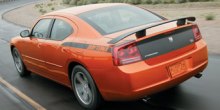 Dodge
Charger was one of the most famous and best-looking muscle cars in
the "good old days" of America. So when Chrysler started a
new wave of muscle sedans with Chrysler 300 / Dodge Magnum, naturally
it thought of resurrecting the Charger nameplate. Dodge
Charger was one of the most famous and best-looking muscle cars in
the "good old days" of America. So when Chrysler started a
new wave of muscle sedans with Chrysler 300 / Dodge Magnum, naturally
it thought of resurrecting the Charger nameplate.
Unfortunately,
fans of the original Charger found the new Charger is nothing other
than a facelifted Chrysler 300. Instead of a fastback coupe, the new
car retains the 4-door sedan format of the Chrysler 300. Basically,
only the sheet metal is different, and this concentrates mostly at
the nose, headlamps, rear fenders, C-pillars, rear window, rear end
design and the addition of tail spoiler. Underneath the bodyshell are
the same mechanicals. Engine includes the 250hp 3.5 V6 and 340hp HEMI
V8. The entry-level 2.7 V6 is dropped because it is considered too
weak to match the performance image of Charger.
Nevertheless,
a sportier version called Daytona R/T is available to the Charger. It
has the HEMI V8 boosted to 350hp by lower back-pressure exhaust, plus
firmer suspensions, grippier tires, better brake pads and revised
steering to improve its handling. |
Verdict:   |
Published
on 8
Jul 2004
|
All rights reserved.
|
|
Dodge Magnum
|
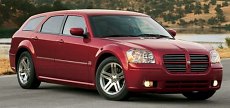 Dodge
Magnum is the wagon version of Chrysler 300. With a truck-like grille
and
less expensive trims, it brings the price to even lower level. At the
same
time, you get more luggage space from the Magnum. Admittedly, it is not
as practical as most European wagons (most notably Volvo V70). Luggage
volume is just 780 litres, much smaller than class average, blame to
the
swoopy roofline and high luggage floor. Luckily, the rear bench can be
folded to increase that to 2023 litres. Dodge
Magnum is the wagon version of Chrysler 300. With a truck-like grille
and
less expensive trims, it brings the price to even lower level. At the
same
time, you get more luggage space from the Magnum. Admittedly, it is not
as practical as most European wagons (most notably Volvo V70). Luggage
volume is just 780 litres, much smaller than class average, blame to
the
swoopy roofline and high luggage floor. Luckily, the rear bench can be
folded to increase that to 2023 litres.
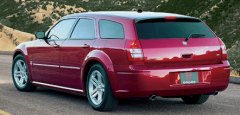 Mechanical-wise,
it is identical
to Chrysler 300. You can still choose between the two V6 and the Hemi
V8.
With the latter, it is one of the fastest wagons on the market. Mechanical-wise,
it is identical
to Chrysler 300. You can still choose between the two V6 and the Hemi
V8.
With the latter, it is one of the fastest wagons on the market. |
Verdict:    |
Published
on 7
Jan 2011
|
All rights reserved.
|
|
Dodge Charger facelift (2011)
|
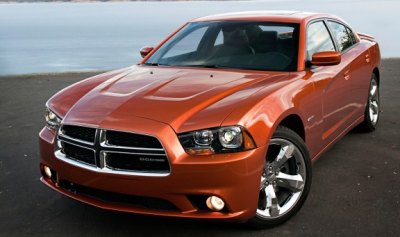 It looks like a mermaid with a bulldog
head.
It looks like a mermaid with a bulldog
head.
In terms of product
development, Chrysler was pretty much in idle for the past 2 to 3
years. Since it went into the hands of Cerberus, an investment firm
that was reluctant to invest, it had been starving for funding. New
product programs were postponed as its owner was looking for ways to
offload it. Then came the big economic crash, Chapter 11 bankruptcy
protection, reorganization and eventual sale to FIAT group. When the
Italian
landed on Auburn Hills, they found an aging (and crappy) model lineup,
and a V6 development program (read "Pentastar") hidden under dust. The
company was still burning cash in alarming rate. How to stop it
bleeding as quickly as possible ? Due to limited time and money,
developing all-new products was out of the question. Instead, FIAT
decided to revamp all the existing cars. Dodge Charger is the first act.
Considering this car took just over one year to develop, the
modifications
and improvements found here are quite respectable. While the
underpinnings are unquestionably carried over from the old car, the
2011 Charger is by no means a conventional facelift. Its clothes have
been completely overhauled. Chrysler even altered its hard points to
make it appear sleeker – the windscreen and rear window are set at
faster angle, and the new C-pillars promote a fastback styling. The
larger windscreen and thinner pillars increase glass area by a good 15
percent. Stylish new LED taillights run the full width of the tail.
Nevertheless, I have reservation on the new front grille. It resembles
those on Dodge trucks, too outrageous for the otherwise sleek design.
In the end, the car looks like a mermaid with a bulldog head.
Well, at least it proves that the new
Charger is a true American design rather than one coming out of Turin -
although I would have preferred otherwise. It's no Alfa Romeo beauty,
and its fans (if any left) will be glad to see the continuation of its
outrageous style.
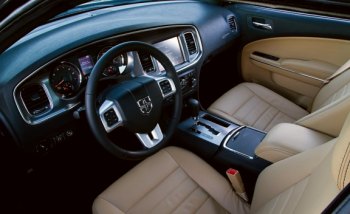 It is vastly improved, undoubtedly,
but that counts from a very low base.
It is vastly improved, undoubtedly,
but that counts from a very low base.
The interior sees a vast improvement of quality and style.
Plastics are
grained and mostly soft-touch. The dash bezel employs some real
aluminum. The leather-trimmed steering wheel becomes smaller and nicer
to hold. The center console houses proper LCD screen. In addition to
the improved outward visibility, this cabin should get few complaints.
Well, our only complaint is the lack of paddle shift. Chrysler said it
will offer ZF 8-speed transmission in the "future", but for now we have
to settle with its old 5-speed auto tranny. It does have manual mode,
but you have to shift the gear lever sideway. Moreover, manual mode
does not give any faster response, so you had better to forget it.
Fortunately, Chrysler finally
completed the development of its 3.6-liter Pentastar V6. Equipped with
high-pressure die-cast aluminum block (which saves weight) and DOHC
intake and exhaust variable cam phasing, it is a vast improvement from
the old 3.5-liter SOHC V6. However, compare with the latest industrial
standard, its lack of direct fuel injection and variable intake
manifolds is not very amusing. That said, its maximum output of 292
horsepower and 260 pound-feet of torque is not bad. Problem is, the
Charger is a 5-meter-plus monster weighing 1.8 ton in its lightest
form. It inevitably results in slower performance and poorer fuel
economy than rivals.
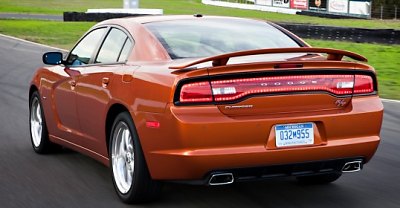 It is the last breed of affordable V8
large cars
It is the last breed of affordable V8
large cars
Performance pursuers had better to try the R/T model, which
is powered
by a 370hp 5.7-liter HEMI V8 (carried over from last year's car). It
gets from rest to 60 in 5.5 seconds. However, don't confuse the R/T
with a sports sedan. It's not a poor man's M5 because it does not have
the sporty chassis tuning required to fulfill that task. It's just a
powerful sedan in American fashion. Yes, it has V8 power and
tire-smoking torque; it has traditional rear-wheel-drive chassis; and
it costs no more than a base BMW 3-series. It is the last breed of
affordable V8 large cars together with Ford Falcon and Holden
Commodore. That is still a good reason for its existence.
On the road, old customers will be glad to find its new
electrohydraulic steering gets quicker ratio, although it is still too
light and lacks feel. Body control and braking are both improved, but
the huge size and substantial weight can never be put behind. On the
other hand, improved noise insulation (e.g. laminated glass and
triple-seal doors) is a welcomed improvement.
Overall, however, the new Charger is hard to recommend. It is vastly
improved, undoubtedly, but that counts from a very low base.
|
Verdict:    |
Published
on 23
Nov 2011
|
All rights reserved.
|
|
Dodge Charger SRT8 6.4
|
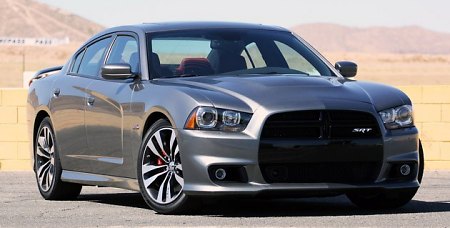
If Chrysler 300 SRT8
is
for good guys, then Dodge Charger SRT8 must be for bad guys. You know,
that sort of things that chased Steve McQueen on the undulating streets
of San Francisco. Bad guys need cars that look bad, of course, and the
Dodge will never disappoint them. It looks crude and outrageous when
emerges in your rearview mirror, especially with a blackened fascia and
pronounced bonnet. Turn your vision to the side, however, it looks far
sleeker and faster than the front would have you believe. The stylish
5-spoke alloy wheels, through which you can see red Brembo calipers,
also lift the game a lot. Its underpinnings might be more or less the
same as Chrysler 300 SRT8, but its appearance is so different that
easily attract different kinds of customers.
In fact, the hottest Charger is supposed to be a cheaper and wilder
alternative to its Chrysler sibling. Money is saved primarily by a
completely different interior, which is less sophisticated than the
Chrysler's but satisfyingly better built than the outgoing car.
Fortunately, it does not sacrifice mechanicals. The same 470 hp / 470
lbft 6.4-liter V8 sits under the hood. The same Mercedes-derived
suspensions and Bilstein adaptive dampers support the four corners.
Therefore its performance and handling are remarkably close to the
Chrysler. If anything makes a different, that must be ride comfort, or
the lack of it. On the Dodge, rear springs are 27 percent stiffer than
those on 300 SRT8. This results in a crude ride on rough surfaces
without bringing any meaningful edge in handling. Switch the damping to
Sport mode will only make things worse.
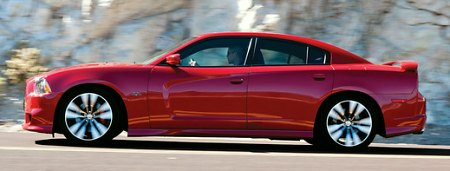
Like the Chrysler, the Charger SRT8 will be praised for strong
performance and an interactive handling that belies its size. Its
weakest link is the 5-speed automatic transmission, whose gearshift is
violent at anything other than feather-light throttle. I prefer the
Chrysler's more expensive packaging and cabin features, but you will be
respected if I see you driving a Charger SRT8. It is a thoroughly
decent performance saloon, especially one asking for so little money.
|
Verdict:     |
Published
on 31
Oct 2014
|
All rights reserved.
|
|
Charger 2014 facelift and SRT Hellcat
|
|
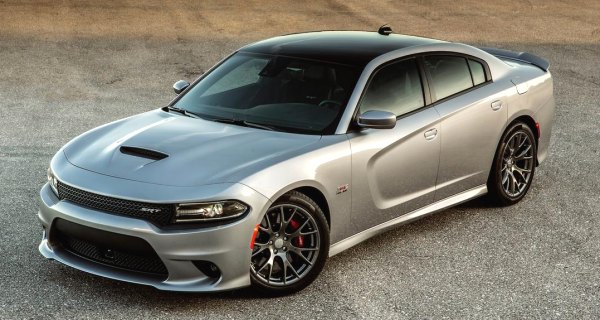 SRT 392 SRT 392 |
It is nice to see
how Chrysler gradually improved its Dodge Charger over the past few
years, transforming it from an old-fashioned American muscle car to a
quite modern machine. In the process, its engines were modernized and
made more powerful, its steering, suspension and brakes were improved,
and its interior was vastly upgraded. However, one weakest link had yet
to be touched – exterior design. I always hate its truck-like front
grille, whose blocky appearance has no aesthetic to speak of. It also
gives an outdated, wind-blocking impression. Fortunately, Chrysler has
finally responded with a major facelift, which reshaped the whole front
end to be a lot rounder and slimmer. The bonnet is more nicely
sculpted. The LED-surrounded headlights are far more stylish. The tail
is also heavily reshaped to look more dynamic. With the exception of
doors and roof, all body panels are new. The Achilles’ heel is finally
sorted.
Apart from facelift, model year 2015 Charger is also improved in a few
areas. The ZF-licensed 8-speed automatic transmission dubbed
TorqueFlite has its availability expanded from V6 to all engines,
including HEMI V8 and SRT models. This should save a couple of tenths
in 0-60 mph sprint while improving fuel economy. While the V6 and 5.7
Hemi are left unchanged, the 6.4-liter engine on SRT 392 now produces
485 hp or an increase of 15 ponies. Its stopping power is also
significantly improved by larger Brembo front brakes, now measure 391
mm instead of 360 mm, while calipers have also been upgraded from
4-piston to 6-piston units. The suspension setup of all models have
been retuned slightly for sharper handling. The electro-hydraulic
steering has been replaced with a new electrical helm to enable
different driving modes to alter steering characteristics. Lastly, the
interior has been improved further with some better trims, a new
steering wheel and an LCD located between the dials. All in all, the
big Dodge has fewer vices than ever to put up with.
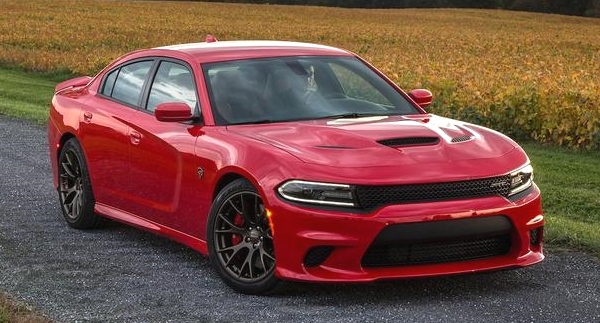 SRT Hellcat SRT Hellcat
|
However, the headline should be the new range-topping model, SRT
Hellcat. As its name suggested, its power comes from the same 6.2-liter
supercharged Hemi as the recent Challenger
Hellcat (read that article for its technical details). Its maximum
output is an astonishing 707 horsepower at 6000 rpm and 650 pound-foot
of torque at 4800 rpm. On the road, it could easily eat the naturally
aspirated SRT 392 for breakfast, finishing 0-60 mph in less than 4
seconds and hitting 100 mph under 8 seconds. That’s faster than BMW M3
and M5, Audi RS6, Jaguar XFR-S and, if not the factor of 4-wheel-drive
traction, Mercedes E63 AMG S 4matic – note that all these rivals bar
the M3 are significantly more expensive. While the Challenger Hellcat
is good for 199 mph flat out, the Charger’s better aerodynamics allows
it to claim an astonishing 204 mph top speed. If that claim is true, it
will beat Aston Martin Rapide S to be the world’s fastest 4-door
production sedan! Can you imagine a Dodge does that?
There are not many things distinguishing the Hellcat from regular SRT
392. Visually, the extra vents on bonnet are the most obvious change,
as they are needed to cool the supercharged motor. Underneath, the
suspension setup are not much different. The brakes are identical, and
the wider 275/40ZR20 rubbers are already available as option on the
lesser car. The only big difference is the steering, because the
Hellcat is the only Charger using old-fashioned hydraulic servo as it
wants to deliver better road feel.
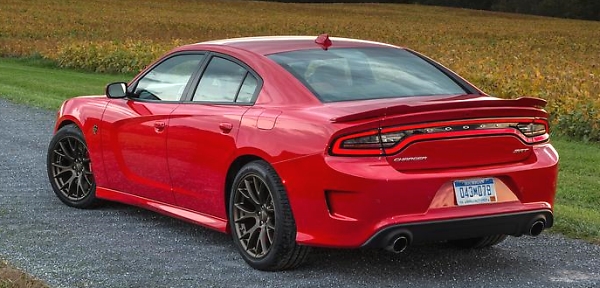 SRT Hellcat SRT Hellcat
|
Compared with the 2-door Challenger Hellcat, the 4-door sedan carries
about 60 kg of extra weight. However, most of that is over the rear
axle, so it has a slightly better front-to-rear weight distribution (at
56:44 versus 57:43). It should offer better traction. The Charger also
employs softer springs and thinner anti-roll bars than the Challenger
to reflect its different role. In the real world, you can always light
up the rear wheels easily if you have the traction control switched off
and pin down the throttle. Nevertheless, drive it in normal way and the
Hellcat is never as scary as its name suggested. It affords enough grip
and traction to deal with spirited road driving. For sure, it is not
destined to track use. Its suspension is too soft to contain roll even
with the Bilstein adaptive dampers set to Track mode. It never quite
shrinks around you like an M5 or E63 AMG, let alone the compact M3.
However, both its steering and handling are quite faithful. The turn-in
is quick enough, understeer is well suppressed and oversteer is
predictable. Even though body roll is more than desired, it rarely
hurts driving confidence. The Brembo brakes do an admirable job to slow
down the 2075 kg monster.
The highlight is the engine, of course. Drive it leisurely and the
6.2-liter supercharged V8 produces a refined burble, while the 8-speed
automatic shifts seamlessly. Floor down the throttle suddenly and all
707 horsepower is unleashed, accompanied with the maddest V8 thunder,
crazy tire smoke and fast-disappearing scenery. Now it feels every bit
the baddest muscle car or, well, a hellcat! American muscle car lovers
should be happy to see Detroit still managed to deliver outrageous
performance at very affordable prices – we are talking about the cost
of a basic M3 in return of 700 horsepower and 200 mph-plus capability.
All the while it hasn’t lost much everyday practicality. This put the
Charger Hellcat in a unique market position.
|
Verdict:
V6 & R/T:   
SRT 392:    
SRT Hellcat:    
|
Published
on 26
Nov 2020
|
All rights reserved.
|
|
Charger SRT Hellcat Redeye
|
|
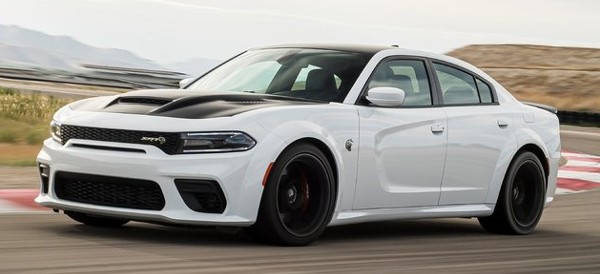
|
|
Is
800 horsepower too much for the old Charger? Dodge thinks not.
|
|
It is unbelievable that
Dodge Charger is 15 years old now. Even if you count since its 2011
mid-cycle revamp, it is almost a decade old. Still, FCA has no plan to
replace it anytime soon. Maybe they will keep it forever… or until its
eventual replacement by an SUV, sadly.
To keep buyers interested, this year the Charger is added with a
flagship performance model, SRT Hellcat Redeye. Changes from the
regular Hellcat is similar to those we have already seen on the Redeye
version of Challenger coupe. The 6.2-liter Hemi V8 gets a larger
supercharger, lifting boost pressure from 0.8 to 1.0 bar. The pistons,
con-rods, lubrication, fuel pumps and airbox are also uprated, as are
the driveshaft and rear axle. Horsepower surges from 707 to 797, making
it once again the most powerful production sedan in the world. Max.
torque improves by 57 lbft to 707 lbft. Chrysler claims 203 mph top
speed, which is actually 1 mph lower than before due to larger frontal
area (more on that later). 0-60 and 100 mph take 3.5 and 7.5 seconds,
respectively, again no better than what the Hellcat achieved back on
its launch 6 years ago. However, in the real world you can feel the
extra grunt. The Redeye is undoubtedly faster in a straight line,
especially at higher speeds.
The Redeye comes standard with “Wide body” chassis, which adds 85 mm
across its extended fenders to accommodate the wider, 305/35ZR20
Pirelli P-Zero rubbers. In response to the criticism that the Hellcat
rides too softly, its suspension has been stiffened significantly. The
front springs get 38 percent stiffer, while anti-roll bars are thicker,
and the Bilstein adaptive dampers are retuned. The steering has been
updated to electric assistance, with 3 modes to choose from.
Admittedly, all these changes are also adopted on the lesser Hellcat
from last year, including the wide body.
On the road, for a car possessing so much power and straight line
performance, the Redeye is quite easy to live with as a daily driver.
Using just a fraction of its throttle travel, the V8 pulls smoothly and
linearly. The 8-speed automatic shifts with a refined manner. The ride
is certainly on the firm side, but in Comfort mode it is smooth enough
to drive to school and supermarket. When you push the car, the firmer
suspension helps body control a lot. The grip generated by those
oversized Pirelli is remarkable. The steering is a bit too light and
numb, but no worse than most German performance sedans. The Brembo
brakes do a respectable job to stop the 2110 kg machine.
But will you buy this car instead of an Alfa Romeo Giulia QF, Mercedes
C63 S or the upcoming BMW M3 Competition? Surely not. Faster on
straight it might be, the Redeye is simply too big and heavy to
exploit. It is too wide for a narrow mountain road and too heavy for
the twisty. Even on a track, you don’t dare to turn off its traction
control, because any careless prod of throttle could spin its rear
wheels. Lacking an electronic LSD doesn’t help taming its evil side.
That is why all German performance sedans possessing 600 or more
horsepower have turned to 4-wheel-drive by now. In fact, at nearly
$90,000, the Redeye is closer to the territory of M5 and E63S than the
aforementioned smaller rivals. That’s simply too much to pay for a
Dodge, let alone one surviving for 15 years, lacking the quality,
refinement and information technology of its much more modern
opponents. The wiser purchase is still the naturally aspirated Scat
pack 392, which can be had with Wide body at almost half the price. You
will lose 300 horsepower, but hardly any fun and practicality.
|
Verdict:    |
|